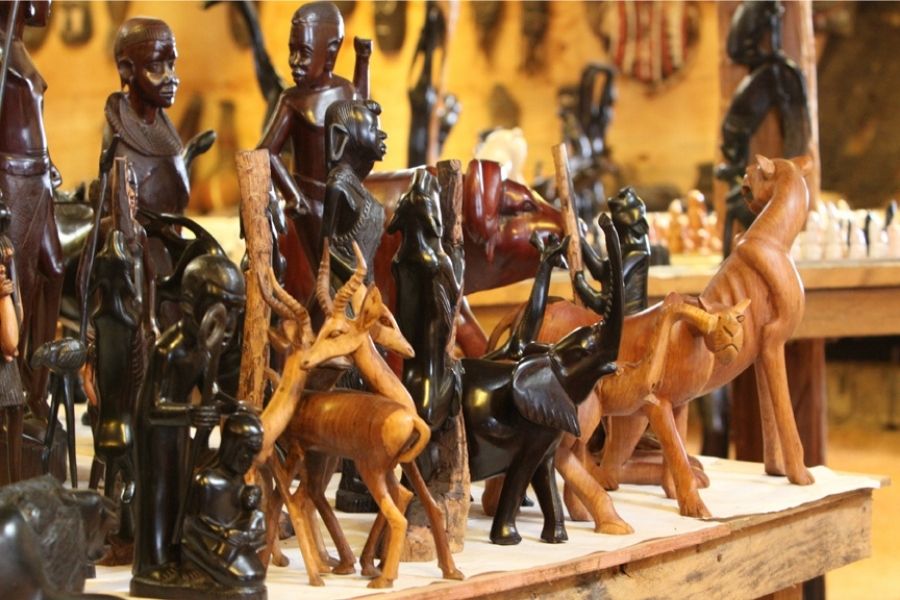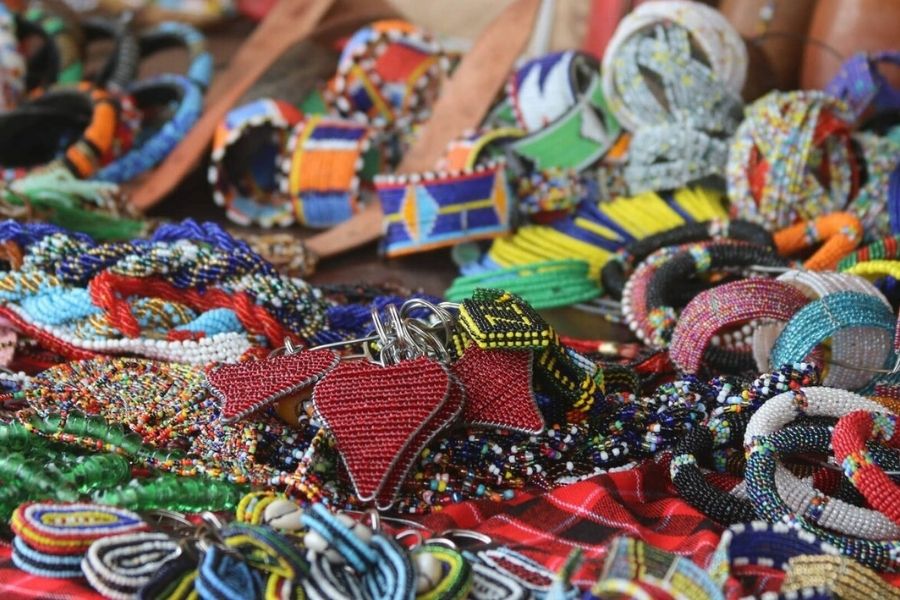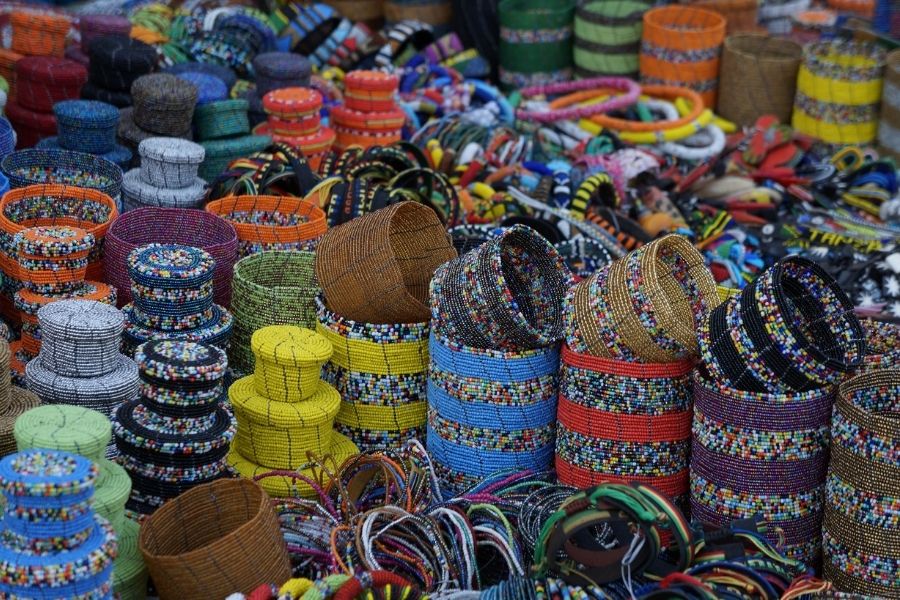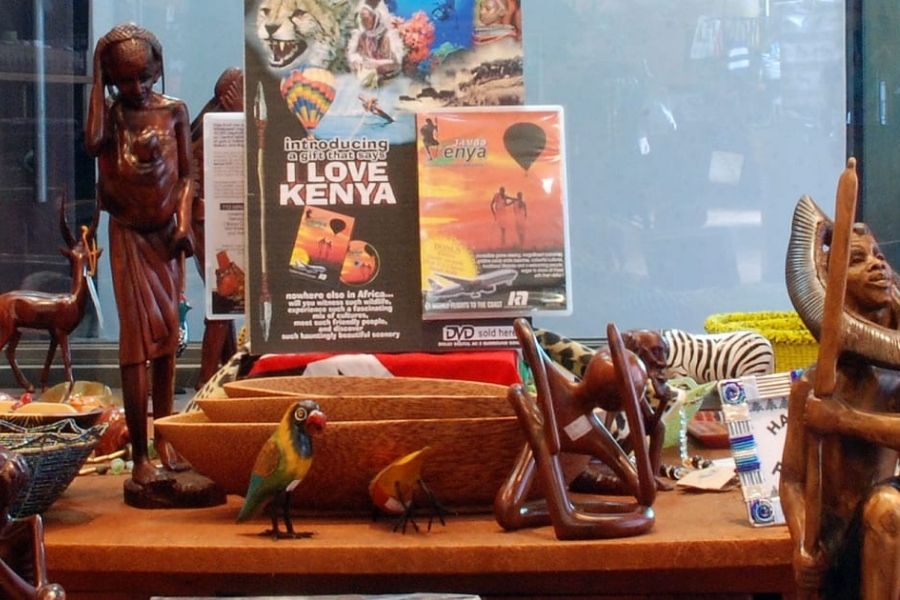Cultural Shopping in Kenya: A Handcrafted Adventure Worth Packing an Extra Bag For
Where beadwork meets storytelling, baskets hold centuries of skill, and every souvenir comes with a soul.
It may not cure everything, but a dose of handcrafted retail therapy in Kenya will definitely lift your spirits. This isn't just shopping. It’s exploration through artistry—a curated walk through workshops, forest-scented candle studios, open-air bead markets, and Swahili-inspired design shops where every purchase comes with a story.
Kenya offers more than safaris. Tucked between the wilderness and the winding streets are some of East Africa’s most vibrant cottage industries, full of soul, color, and cultural connection. Whether you’re into beaded belts, bold sarongs, carved soapstone, or eco-conscious decor, you’re guaranteed to find something beautiful and meaningful.
Let’s take a stroll through Kenya’s most memorable shopping experiences, woven into your travel itinerary and enriched by the people and places that make them.
Curio Shops and Artisan Markets: Where Culture Meets Craft
Across Kenya, you’ll find curio shops—open-air or boutique-style stalls brimming with local treasures. These are not just souvenir outlets—they’re living museums of tribal creativity.
Here’s what you’re likely to discover:
◾ Hand-beaded Maasai belts and jewelry – Made by women’s groups across southern Kenya, using traditional techniques passed down for generations. Each color has meaning: red for bravery, white for purity, and blue for energy.
◾ Sisal baskets from the Taita and Kamba communities – Woven from dyed agave fibers, perfect for home decor or carrying treasures from the market.
◾ Kikoys and Khangas – Colorful wraps for men and women used as skirts, scarves, curtains, or even picnic cloths. Kikoys are cotton and coastal, while Khangas come with proverbs printed on them in Swahili.
◾ Carved wood and soapstone sculptures – Elephants, giraffes, or abstract tribal masks made in Kisii (famous for soapstone), Wamunyu (for wood), and parts of Samburu and Turkana.
◾ Malachite and Tanzanite jewelry – Ethically sourced and hand-set in Nairobi’s gemstone markets.
◾ Cow horn and banana leaf accessories – Eco-friendly and striking, perfect for one-of-a-kind wearable art.
◾ Beaded leather sandals – Intricately handmade by artisans in Nairobi’s Eastleigh and Karen areas, often run by Maasai cooperatives.
You’ll find these treasures at places like Kazuri Beads Factory in Karen, Utamaduni Craft Centre, or even curio lanes in Mombasa’s Old Town. Each stall is a conversation, each item a journey.
Cultural Stop Suggestion: Pair your visit with a guided walk through a Maasai or Kamba village to understand the symbolism and storytelling behind each pattern, bead, or carving.
Craft Villages & Coastal Handicraft Centers: Redefining the Beach Market
Gone are the days when “beach boys” peddled wares along the shoreline. Kenya’s tourism industry has made a smart shift—many of these former vendors now work in structured artisan centers, especially along the coast.
In places like Watamu, Diani, and Malindi, you can now:
◾ Watch women twist sisal into baskets, mats, and bags
◾ See painters' handbrush colorful wildlife scenes on banana paper
◾ Shop for Swahili chests, dhow-wood daybeds, and ostrich eggshell lamps
◾ Get a tailored Swahili-style outfit sewn from kitenge fabric while you wait
Recommended Stop: Visit the Bombolulu Workshops and Cultural Centre in Mombasa—a social enterprise empowering differently-abled artisans to produce world-class jewelry, leather goods, and decor.
Birding Add-On: Combine with a visit to Arabuko Sokoke Forest nearby—home to the Sokoke scops owl and rare Clarke’s weaver.
Old Town Mombasa & Fort Jesus Market – Where History Speaks in Silk and Sandalwood
If you’re ending your safari adventure at the coast, Mombasa’s Old Town is a must-visit not just for its ancient streets—but for its storied shopping.
Here, beneath the centuries-old walls of Fort Jesus, built by the Portuguese in the 1590s and later used by Arabs and Omanis, lies a market of memories.
You’ll find:
◾ Omani daggers and brass lamps – carried through the centuries by seafarers from across the Indian Ocean
◾ Swahili chests (vitanda vya Kiswahili) – made from carved mango or dhow wood, decorated with brass studs
◾ Hand-woven kikapu (palm baskets) from the Giriama tribe, ideal for storage or beach wear
◾ Fragrant sandalwood and frankincense oils, cloves, and henna powders from coastal traders
◾ Kanzu (long white tunics) and buibui (black coastal robes) – traditional Muslim wear with intricate lace or gold-thread embroidery
Meander through the Arab street-style alleys, and you’ll find that every item every brass bangle or incense cone—is infused with Omani, Swahili, and Indian influences.
Cultural Insight: Ask about the history behind each design. Many artisans are descendants of Swahili-Arab lineages, with stories linking back to Zanzibar and Oman.
Shopping tip: Visit just after sunrise or late afternoon to avoid the heat and enjoy atmospheric walks as the call to prayer echoes through coral-stone walls.
Cultural Villages: Directly Supporting Women Artisans and Tribal Creators
During your visits to a Maasai boma, a Samburu manyatta, or a Turkana lakeside homestead, you’ll often be invited to browse a small makeshift market—usually laid out on vibrant kangas under an acacia tree.
These items are not imported souvenirs—they’re the real thing, handmade by the women and children you meet during your cultural experience.
Here’s what to expect:
◾ Beaded collars and earrings – Hand-strung by Maasai and Samburu women, each bead color symbolizing peace, bravery, or family status
◾ Mini shields and spears – Carved by Turkana elders or painted by boys in between herding duties
◾ Clay pots, woven mats, or gourd flasks – Used daily in homes, and now available in smaller, decorative versions
◾ Traditional rattles, flutes, and bows – Popular with kids, and occasionally available for purchase
Why it matters: Every coin you spend here goes straight to the hands of the creator, often covering school fees, medical costs, or household food.
These aren’t just keepsakes—they are micro-donations with dignity, tied to real faces and real lives.
Don’t Forget the Coffee and Tea – Aromatic, Organic, Unforgettable
Beyond carvings and cloth, Kenya offers two other iconic, edible souvenirs: its highland-grown coffee and rich-flavored tea.
During a coffee farm tour in Nyeri or Kiambu, or a tea plantation walk in Kericho, you’ll learn how these exports are grown, picked, dried, roasted, and packed.
And yes, you can take them home.
Here’s what to look for:
◾ AA-grade Kenyan Coffee – Bold, winey, complex. The world’s best baristas swear by it.
◾ Purple or green loose-leaf tea – Including orthodox whole-leaf, CTC (crush-tear-curl), and even hand-rolled oolong variants
◾ Safari-branded souvenir tins, or local cooperative packs sealed at origin
Tip: Ask your Blavals guide to stop at a farm shop where you can buy freshly ground coffee or vacuum-packed tea—straight from the plantation. They make excellent gifts and even better memories.
Kenya’s Cottage Industry: Art, Design & Everyday Elegance
Behind the boutique front is a thriving cottage industry movement. Across Nairobi, Nanyuki, and the Rift Valley, you’ll find homestead-based artisans creating globally admired goods:
◾ Masai beeswax candles – Clean-burning, aromatic, and beautifully molded
Visit:
◾ Marula Studios (Ocean Sole Complex) – Karen, Nairobi
◾ Ol Tukai Lodge Shop – Amboseli National Park
◾ Cinnabar Green (natural cosmetics & beeswax) – Nanyuki
What to Expect:
Candles made from wild-harvested Maasai land beehives, infused with scents like lemongrass, vanilla, or African myrrh. Often come in gourd holders or recycled glass.
Ask about how beekeeping supports elephant conservation by deterring crop-raiding.
◾ Sheepskin slippers from Meru and Nyandarua—lined with highland fleece.
Visit:
◾ Nyandarua Women's Co-op (Enquire through Blavals)
◾ Meru Town Craft Market
What to Expect:
Highland sheep provide the fleece. Women clean, card, and sew the wool into soft slippers, often with leather soles or bead inlays.
◾ Natural-dyed wool sweaters in rich earthy tones from Samburu women’s collectives.
Visit:
◾ Samburu Women’s Centre – Maralal (pre-arranged visit)
◾ Nanyuki Craft Market – Monthly eco-market featuring these products
What to Expect:
Wool dyed using acacia bark, ochre, turmeric, or aloe, then hand-knitted into cozy pullovers or scarves.
Colorful but subtle—perfect for gifting or layering on chilly Kenyan nights.
◾ Hand-thrown terracotta and pottery from Nanyuki studios.
Visit:
◾ Nanyuki Ceramics Studio
◾ Kifaru Pottery (Laikipia County)
What to Expect:
Bowls, plates, tagines, and planters made from local red clay, fired in wood kilns, and sometimes painted with Maasai motifs or wildlife silhouettes.
Classes are available for guests staying near Ol Pejeta or Mount Kenya.
◾ Swahili-inspired furniture – Dhow wood benches, copper lampshades, and engraved Zanzibar doors.
Visit:
◾ Lamu Old Town – Along the coast
◾ Mombasa's Marikiti Curio Shops
What to Expect:
Crafted from dhow wood, mango, or mahogany, these include Zanzibar-style chests, brass-studded benches, and arched headboards. Many pieces feature hand carving passed down through Swahili-Arab traditions.
For the home enthusiast, Kenya offers Milan-worthy interior design finds, but with an African soul.
Best Place to See This in Action: Spinners Web Nairobi or Kitengela Glass Studio—where recycled glass turns into chandeliers and vases in an artist village you can walk through.
◾ Watch Women Twist Sisal – Basketry in Action
Visit:
◾ Taita Women’s Basket Weavers – Wundanyi
◾ Kazuri Beads & Baskets – Nairobi
What to Expect:
Sisal is stripped, dyed using plant colors, and woven into bags, rugs, and planters. Many are made under the shade of acacias while stories are shared—a living tradition of womanhood.
◾ Banana Paper Art & Swahili Paintings
Visit:
◾ Wangari Art Studio – Watamu
◾ Mtepeni Artists Collective – Kilifi County
What to Expect:
Banana fiber pulps transformed into canvas, where artists hand-paint zebras, baobabs, and sunlit coastlines. Popular among eco-tourists and galleries.
◾ Tailored Swahili-Style Kitenge Outfits
Visit:
◾ Mombasa Old Town (Fort Jesus tailors)
◾ TuliTuli Studio – Lamu Town
What to Expect:
Choose from a wall of kitenge prints, sit down with a tailor, and have a custom buibui, dress, shirt, or jumpsuit sewn for you by the next day. They often offer fittings over Swahili tea and biscuits.
Contemporary Kenyan Fashion: Local Materials, Global Runways
Kenya’s fashion scene is rising fast. From runway-ready collections in Nairobi’s design districts to custom-fit safari wear, local fashion houses are rewriting what African style means.
What to look out for:
◾ Nairobi-based leather brands like Sandstorm and Adele Dejak
What to Expect:
◾ Sandstorm Kenya makes rugged safari-ready leather bags, inspired by canvas tents of colonial expeditions. Travelers can tour the small workshop (by appointment), meet the craftspeople, and even request custom initials stamped into their gear.
◾ Adele Dejak fuses bold African design with European minimalism. Her accessories, belts, and handbags are handcrafted using upcycled brass, recycled cow horn, and Ankole bone.
Why It’s Special:
Perfect for travelers who want functional fashion that reflects Kenya’s wild elegance. Bags and accessories are built for safari, airport transits, or city wear—and last a lifetime.
◾ Silk dresses with bead embroidery from Maasai and Samburu motifs
What to Expect:
Kenyan designers increasingly collaborate with Maasai and Samburu women’s groups to incorporate traditional bead patterns into contemporary gowns and silk evening dresses.
◾ The beadwork is hand-sewn onto necklines, waistbands, or sleeves—symbolizing warrior strength or fertility.
◾ Samburu colors tend to be more vibrant and triangular, while Maasai bead designs are more circular and symbolic.
Traveler Tip:
Book a studio appointment or a cultural visit with women’s cooperatives for custom fitting or purchase. Many designers offer shipping and resizing services for international clients.
◾ Eco-conscious fashion made from recycled kitenge, sisal, and even bottle caps
What to Expect:
Artisans use discarded bottle caps, kitenge scraps, and old rice sacks to create fashion-forward pieces: skirts, patchwork jackets, laptop sleeves, and jewelry.
Or take an art walk in Lamu, where Swahili art meets Omani calligraphy, or in Kitengela, where sculptures bloom like trees.
Art + Adventure: Want to create your own piece? Try a soapstone carving class in Kisii or a batik workshop on the coast.
Some studios also offer “design-your-own” workshops where travelers can upcycle their own items (e.g., safari hats or boots).
Sustainability Tip:
Buy directly from the artisan or their collective—your purchase diverts waste and empowers creative livelihoods in urban Kenya.
◾ Custom safari gear—perfectly tailored linen shirts and wrap skirts for the bush
What to Expect:
Made-to-measure linen safari shirts, cargo trousers, wrap skirts, and utility dresses designed for the bush. Some designers use natural plant dyes, mosquito-repellent fabric treatments, or sun-reflective weaves.
Want something personalized? Ask Blavals to arrange a visit to a fashion atelier where you can meet the designer, choose your colors, and get fitted.
Kenya’s Contemporary Art Scene: More Than Just Carvings
Move beyond masks. Kenya’s modern artists are redefining what African art means—mixing urban graffiti, abstract wildlife, sculpture, and portraiture into thought-provoking pieces.
Or take an art walk in Lamu, where Swahili art meets Omani calligraphy, or in Kitengela, where sculptures bloom like trees.
Art + Adventure: Want to create your own piece? Try a soapstone carving class in Kisii or a batik workshop on the coast.
In Nairobi, explore galleries like:
◾ Circle Art Gallery – Contemporary paintings, installations.
What to Expect:
Kenya’s premier space for African contemporary art, featuring rotating exhibitions from East African painters, sculptors, and digital artists. Works are themed around environment, gender, identity, and wildlife.
Private viewings, artist meetups, and investment guidance are available on request.
◾ Matbronze Wildlife Art – Life-size bronze sculptures.
What to Expect:
Walk through a lush garden gallery filled with bronze lions, buffalo, cheetahs, eagles, warthogs, and more—some life-size, others collectible. All are made by Kenyan founder Denis Mathews using the lost wax technique.
Onsite café, workshops, and wildlife talks included.
Traveler Tip:
Small figurines fit in luggage. Large pieces can be shipped with insurance.
◾ Banana Hill Art Gallery – Abstract art with a Pan-African twist.
What to Expect:
A lively, welcoming space showcasing over 50 Kenyan and Pan-African artists—specializing in vivid abstracts, landscapes, expressionism, and Afro-futurism.
Often hosts live painting events and artist Q&A sessions.
A Real Encounter at a Curio Shop – Carvings, Conversations & Craftsmanship
You’re heading from Nairobi to the Maasai Mara, and your driver slows down along the Narok highway just outside Mai Mahiu. On the roadside is a vibrant, shaded curio shop with rows of carved giraffes, rhino sculptures, beaded necklaces, colorful baskets, and kitenge fabrics hanging like flags.
The shop is small but packed—the kind of treasure trove you’d miss if you blinked. It’s locally run, honest, and handpicked by Blavals for its community-backed ethics.
As you step inside, you’re met by Mzee Joseph, a master woodcarver and storyteller. He’s been carving for 30 years, long before tarmac roads or safari vans were passing by.
He greets you with warmth, invites you to sit, and offers a short explanation about the Makonde carving style he uses, passed down from Tanzanian roots and adapted by the Kamba community in Kenya.
He shows you a 2-foot-tall elephant carved from jacaranda wood, its tusks inlaid with bone, and its ears stretched mid-trumpet. You ask for the price.
“12,000 shillings,” he says with a smile.
You pause. You’re unsure. You’ve never negotiated before. Is that fair?
He notices. “You’re my first customer today,” he adds, inviting negotiation-not, not as a hustle, but as part of the experience.
How to Choose & Negotiate at a Curio Shop in Kenya – Smart Traveler Tips
Shopping at curio shops is one of the most culturally immersive, rewarding experiences you can have. But it helps to be informed.
1. Assess the Quality of the Craftsmanship
◾ Check material quality: Hardwoods like ebony and mahogany feel heavier and smoother. Avoid ultra-light pieces—they’re likely softwood or mass-produced.
◾ Look at tool marks: Handmade carvings have slight imperfections or tool textures. Machine-cut ones look perfect but lack soul.
◾ Ask what tribal style the carving reflects—Maasai spears, Swahili doors, Kamba masks, Luhya drums all have meaning.
2. Ask About the Artist
Most good sellers will proudly tell you who made the piece—and often, the artisan is right there. Buying directly supports families and entire communities.
3. Negotiate Respectfully
◾ Always smile. Politeness goes far.
◾ Start by offering 60–70% of the quoted price.
◾ Be prepared to walk away—but often, the seller will offer a final, fair middle-ground.
◾ Bundle items for a better deal: “What if I take the giraffe and this soapstone bowl—what’s your price?”
4. Carry Cash, But Know Mobile Money Works Too
◾ Cash in Kenyan Shillings (KES) is king, especially in rural shops.
◾ In urban or tourist-curated centers, you can pay via M-Pesa (mobile money) or even card.
◾ Avoid USD unless agreed upon—it may result in inflated prices or unfavorable exchange rates.
5. Know What You Can (and Can’t) Export
◾ Avoid items made from ivory, turtle shell, or endangered hardwoods—they’re illegal to export and unethical.
◾ Blavals-approved curio stops are all vetted for legal sourcing and community benefit.
Return home with more than memories—bring back handmade joy.
Frequently Asked Questions (FAQ)
◾ Q: Is it safe to shop in Kenyan markets?
Yes. We recommend shopping with a trusted guide or in organized centers. Blavals Safaris only partners with vetted artisans and cooperatives.
Yes. We recommend shopping with a trusted guide or in organized centers. Blavals Safaris only partners with vetted artisans and cooperatives.
◾ Q: Will I have time for shopping during a safari?
Definitely. Our custom itineraries allow flexibility for stops at craft centers, markets, or workshops.
Definitely. Our custom itineraries allow flexibility for stops at craft centers, markets, or workshops.
◾ Q: Can I carry art or carved wood out of Kenya?
Yes, but some items may require clearance (like ebony). We assist with permits and packaging.
Yes, but some items may require clearance (like ebony). We assist with permits and packaging.
◾ Q: Is bargaining expected?
In markets, yes—negotiation is part of the fun! In formal shops or cooperatives, prices are usually fixed.
In markets, yes—negotiation is part of the fun! In formal shops or cooperatives, prices are usually fixed.
◾ Q: What are the best souvenirs to buy in Kenya?
Beaded jewelry, sisal baskets, kikoys, soapstone, hand-blown glass, Swahili decor, and eco-friendly fashion.
Beaded jewelry, sisal baskets, kikoys, soapstone, hand-blown glass, Swahili decor, and eco-friendly fashion.
Let Blavals Curate Your Cultural Safari + Shopping Experience
At Blavals Safaris, we believe travel should leave your soul—and your suitcase—full. From tribal artisan visits to contemporary studios, we’ll help you discover Kenya’s finest creative minds and support sustainable tourism while you’re at it.
Ready to blend wild adventure with design, craft, and cultural depth?






